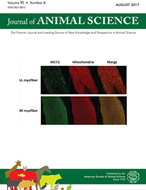-
Views
-
Cite
Cite
S. L. Lake, E. J. Scholljegerdes, R. L. Atkinson, V. Nayigihugu, S. I. Paisley, D. C. Rule, G. E. Moss, T. J. Robinson, B. W. Hess, Body condition score at parturition and postpartum supplemental fat effects on cow and calf performance, Journal of Animal Science, Volume 83, Issue 12, December 2005, Pages 2908–2917, https://doi.org/10.2527/2005.83122908x
Close - Share Icon Share
Abstract
Three-year-old Angus × Gelbvieh beef cows nutritionally managed to achieve a BCS of 4 ± 0.07 (479.3 ± 36.3 kg of BW) or 6 ± 0.07 (579.6 ± 53.1 kg of BW) at parturition were used in a 2-yr experiment (n = 36/yr) to determine the effects of prepartum energy balance and postpartum lipid supplementation on cow and calf performance. Beginning 3 d postpartum, cows within each BCS were assigned randomly to be fed hay and a low-fat control supplement or supplements with either high-linoleate cracked safflower seeds or high-oleate cracked safflower seeds until d 60 of lactation. Diets were formulated to be isonitrogenous and isocaloric, and safflower seed supplements were provided to achieve 5% of DMI as fat. Ultrasonic 12th rib fat and LM area were lower (P < 0.001) for cows in BCS 4 compared with BCS 6 cows throughout the study. Cows in BCS 4 at parturition maintained (P = 0.02) condition over the course of the study, whereas cows in BCS 6 lost condition. No differences (P = 0.44 to 0.71) were detected for milk yield, milk energy, milk fat percentage, or milk lactose percentage because of BCS; however, milk protein percentage was less (P = 0.03) for BCS 4 cows. First-service conception rates did not differ (P = 0.22) because of BCS at parturition, but overall pregnancy rate was greater (P = 0.02) in BCS 6 cows. No differences (P = 0.48 to 0.83) were detected in calf birth weight or ADG because of BCS at parturition. Dietary lipid supplementation did not influence (P = 0.23 to 0.96) cow BW change, BCS change, 12th rib fat, LM area, milk yield, milk energy, milk fat percentage, milk lactose percentage, first service conception, overall pregnancy rates, or calf performance. Although cows in BCS of 4 at parturition seemed capable of maintaining BCS during lactation, the overall decrease in pregnancy rate indicates cows should be managed to achieve a BCS >4 before parturition to improve reproductive success.





